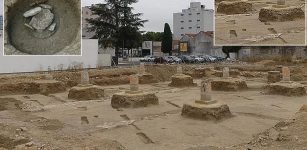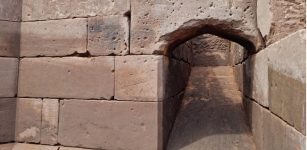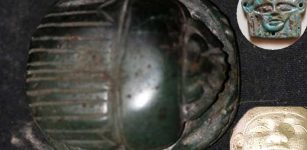Astonishing Pre-Inca Salt Ponds of Maras In Peru Were Created By The Chanapata Culture
Ellen Lloyd - AncientPages.com - There are many wonderful places to see in Peru, a land rich in history and filled with beauty. Most people have heard of Machu Picchu, the enigmatic Nazca Lines, but not everyone is familiar with the astonishing salt pond of Maras in the Sacred Valley of the Incas, 40 kilometers north of Cuzco.
The salt pans of Maras- Diego Delso - CC BY-SA 4.0
The Maras salt ponds are at an altitude of 3,000 meters. And though it is a long way to the ocean, it wasn’t always so. In the ancient past, this impressive mountain range was once part of the seafloor.
The Incas used salt ponds, but they were originally created during the Chanapata culture (AD 200 to AD 900). The Chanapata culture extended around the entire Cusco Valley, and their settlers reached a higher degree of civilization as they developed agriculture and domestic animal raising.
It is not known by how many years this maze of channels predates the Inca Empire, but the construction of the salt ponds undertaken by the Chanapata culture must have taken generations.
If you were not afraid of hard work and you wanted to make money, the Mara salt ponds were a good place to go, but being at the end of a vertiginous mountain road, the site is even today considered inaccessible.
Maras salt ponds - Cusco Region, Peru; built in AD200-AD900 by the Chanapata culture, pre-dating the Incas. Image credit: AlisonRuthHughes - CC BY-SA 4.0
One can only imagine how hard it must have been to reach this place during the Inca time and how much work it required to transport the salt to all corners of the vast Inca empire.
Even at its source, its collection was not as straightforward as simply raking it from the ground. Over centuries, a network of ponds was created with an ingenious method of water control, which ensured a steady supply of the valuable commodity.
The keeper of each pond lets water into their pool by opening a notch in the sidewall. Each pond is about 30cm deep; when it is full, the water evaporates in the dry Andean air. When the pool has crusted over, the keeper uses a wooden baton to scrape up the salt, which is put in a basket to drain.
The salt mines have traditionally been available to anyone wishing to harvest salt. The salt pond owners must be community members and families that are new to the community wishing to propitiate a salt pond get the one farthest from the community. The size of the salt pond assigned to a family depends on the family's size.
Usually, there are many unused salt pools available to be farmed. All any prospective salt farmer must do is locate an empty, currently unmaintained pond, consult with the local informal cooperative, learn how to keep a pond properly within the accepted communal system, and start working.
Today, the salt ponds of Maras are a tourist attraction, and if you are in Peru, they are worth a visit.
Updated on August 24, 2023
Written by: Ellen Lloyd - AncientPages.com
Copyright © AncientPages.com All rights reserved. This material may not be published, broadcast, rewritten or redistributed in whole or part without the express written permission of AncientPages.com
More From Ancient Pages
-
 More Than 2,500 Years Old Gallic Tombs Unearthed In Nîmes, Southern France
Archaeology | Aug 17, 2020
More Than 2,500 Years Old Gallic Tombs Unearthed In Nîmes, Southern France
Archaeology | Aug 17, 2020 -
 Strange Case Of The Vampire Doctor And The Dark Figure Remains Unexplained
Featured Stories | Oct 6, 2024
Strange Case Of The Vampire Doctor And The Dark Figure Remains Unexplained
Featured Stories | Oct 6, 2024 -
 Unexpected Archaeological Discovery May Re-Write English Civil War History
Archaeology | Feb 3, 2023
Unexpected Archaeological Discovery May Re-Write English Civil War History
Archaeology | Feb 3, 2023 -
 Sinister Manchac Swamp And The Chilling Curse Of Julia Brown
Featured Stories | Aug 25, 2021
Sinister Manchac Swamp And The Chilling Curse Of Julia Brown
Featured Stories | Aug 25, 2021 -
 Are Thunderbird Petroglyphs In Bighorn Basin Linked To Golden Eagle Nests?
Civilizations | Apr 26, 2017
Are Thunderbird Petroglyphs In Bighorn Basin Linked To Golden Eagle Nests?
Civilizations | Apr 26, 2017 -
 Encounter Between Neanderthals And Homo Sapiens – Genome Study Traces The History
DNA | Oct 18, 2023
Encounter Between Neanderthals And Homo Sapiens – Genome Study Traces The History
DNA | Oct 18, 2023 -
 The Maya Produced Rubber 3,000 Years Before Goodyear
Ancient History Facts | Mar 12, 2016
The Maya Produced Rubber 3,000 Years Before Goodyear
Ancient History Facts | Mar 12, 2016 -
 Echo And Narcissus: Cursed Ability To Speak And Punishment Of Selfish Love And Vanity
Featured Stories | Feb 9, 2021
Echo And Narcissus: Cursed Ability To Speak And Punishment Of Selfish Love And Vanity
Featured Stories | Feb 9, 2021 -
 Ancient Romans Invented The First Bound Book
Ancient History Facts | Sep 25, 2017
Ancient Romans Invented The First Bound Book
Ancient History Facts | Sep 25, 2017 -
 Ancient City Of Adab That Flourished In North Sumer
Civilizations | Jul 19, 2017
Ancient City Of Adab That Flourished In North Sumer
Civilizations | Jul 19, 2017 -
 Well-Preserved Neolithic Settlement Discovered Near Kutná Hora, Czech Republic
Archaeology | Aug 2, 2024
Well-Preserved Neolithic Settlement Discovered Near Kutná Hora, Czech Republic
Archaeology | Aug 2, 2024 -
 Long-Lost Legendary Ancient Temple Discovered On San Miguel Hill In Mexico
Archaeology | Oct 20, 2023
Long-Lost Legendary Ancient Temple Discovered On San Miguel Hill In Mexico
Archaeology | Oct 20, 2023 -
 Amulets, Figurines Discovered In Recently Unearthed Limestone Sarcophagus In Minya, Egypt
Archaeology | Oct 15, 2020
Amulets, Figurines Discovered In Recently Unearthed Limestone Sarcophagus In Minya, Egypt
Archaeology | Oct 15, 2020 -
 Mystery Surrounds Newly Discovered Bronze Age Burial In Southwest England
Archaeology | May 21, 2018
Mystery Surrounds Newly Discovered Bronze Age Burial In Southwest England
Archaeology | May 21, 2018 -
 Challenging Prehistoric Gender Roles – Women Were Hunters Too – Not Just Men
Archaeology | Oct 21, 2023
Challenging Prehistoric Gender Roles – Women Were Hunters Too – Not Just Men
Archaeology | Oct 21, 2023 -
 Mysterious White Chinese May Be Related To Ancient Roman Soldiers – Did Marcus Crassus’ Army Settle Down In The Gobi Desert?
Civilizations | Dec 29, 2017
Mysterious White Chinese May Be Related To Ancient Roman Soldiers – Did Marcus Crassus’ Army Settle Down In The Gobi Desert?
Civilizations | Dec 29, 2017 -
 Rare Bulla (Seal) And 2,600-Year-Old Stamp With Biblical Name Unearthed In City Of David
Archaeology | Apr 3, 2019
Rare Bulla (Seal) And 2,600-Year-Old Stamp With Biblical Name Unearthed In City Of David
Archaeology | Apr 3, 2019 -
 Llangernyw Yew: Chilling Prophecy Of The Oldest Tree In Wales
Featured Stories | Oct 28, 2022
Llangernyw Yew: Chilling Prophecy Of The Oldest Tree In Wales
Featured Stories | Oct 28, 2022 -
 King Sanakht: Mysterious Ancient Egyptian Pharaoh Was A ‘Giant’ – Scientists Say
Archaeology | Aug 9, 2017
King Sanakht: Mysterious Ancient Egyptian Pharaoh Was A ‘Giant’ – Scientists Say
Archaeology | Aug 9, 2017 -
 First Fossils Of Ancient Human Relatives Sent To Space – Tribute To Science And Our Ancient History
Fossils | Sep 12, 2023
First Fossils Of Ancient Human Relatives Sent To Space – Tribute To Science And Our Ancient History
Fossils | Sep 12, 2023


